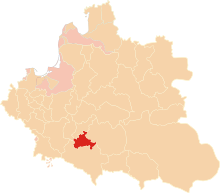Belz Voivodeship
This article has multiple issues. Please help improve it or discuss these issues on the talk page. (Learn how and when to remove these template messages)
|
| Bełz Voivodeship Województwo bełskie Белзьке воєводство | |||||||||
|---|---|---|---|---|---|---|---|---|---|
| Voivodeship of Polish–Lithuanian Commonwealth1 | |||||||||
| 1462–1793 | |||||||||
 Bełz Voivodeship of the Polish–Lithuanian Commonwealth. | |||||||||
| Capital | Belz | ||||||||
| Area | |||||||||
• | 9,000 km2 (3,500 sq mi) | ||||||||
| History | |||||||||
• Established | 1462 | ||||||||
| 1793 | |||||||||
| Political subdivisions | counties: 4 plus 1 land | ||||||||
| |||||||||
| ¹ Voivodeship of the Kingdom of Poland before 1569. | |||||||||
Bełz Voivodeship (
History
Bełz Voivodeship was formed in 1462 from the territories of the Duchy of Belz, after the Duchy was annexed by the Crown of the Kingdom of Poland. Zygmunt Gloger in his monumental book Historical Geography of the Lands of Old Poland gives a detailed description of the voivodeship:[1]
“Belz, on the Zaloka river, was one of the oldest
The newly created Belz Voivodeship was slightly smaller than Lublin Voivodeship at approximately the same size as the Chełm Land. It was made of three counties: Lubaczów, Horodło and Szewlock, and in 1767, it was divided into the counties of Bełz, Grabowiec, Horodło, Lubaczów, and the Land of Busk. At local sejmiks in Belz, five deputies to the Sejm were elected, and the voivodeship had four starostas: Belz, Busk, Grabowiec and Horodlo (...) In the 17th century, the voivodeship, which was the smaller of all Lesser Poland voivodeships, had 483 villages and 33 towns (...) After the first partition of Poland (1772), almost whole voivodeship was annexed by the Habsburg Empire, as part of Galicia. What remained in Poland were towns of Dubienka and Korytnica, together with some villages (...) In 1793 the voivodeship ceased to exist, as after the second partition of Poland, its remaining parts were annexed by the newly created Chełm Voivodeship and Włodzimierz Voivodeship".
The area received an influx of szlachta from Mazovia, Lesser Poland and Greater Poland. In 1570–1580, 79% of the local noble families (among those of known provenance) was of Polish origin, while the percentage of Ruthenian and Wallachian noble families amounted to 15% and 4% respectively. Peasant strata of the population remained the least affected by migrations from the west.[2][3]
Municipal government
Voivodeship Governor (
- Bełz
Regional council (
Regional council (sejmik) seats:
- Bełz
Administrative division
- Bełz
- Grabowiec County, (Powiat Grabowiecki), Grabowiec
- Horodło County, (Powiat Horodelski), Horodło
- Lubaczów County, (Powiat Lubaczowski), Lubaczów
- Busk Land, (Ziemia Buska), Busk
Voivodes
- Rafał Leszczyński (1579-1636)(1619–1636)
- Jakub Sobieski (from 1638)
- Adam Mikołaj Sieniawski (from 1692 to 1710)
- Stanisław Mateusz Rzewuski (from 1726)
Neighbouring Voivodeships and regions
- Ruthenian Voivodeship
- Volhynian Voivodeship
- Lublin Voivodeship
References
- ^ Gloger, Zygmunt (1903). "Województwo Bełskie". Geografia historyczna ziem dawnej Polski (in Polish). Kraków. Retrieved 19 June 2017.
{{cite book}}: CS1 maint: location missing publisher (link) - ^ Janeczek, Andrzej (1991). Osadnictwo pogranicza polsko-ruskiego: województwo bełskie od schyłku XIV do początku XVII (in Polish). PAN. pp. 123–124.
- ^ Kość, Józef (1999). Polszczyzna południowokresowa na polsko-ukraińskim pograniczu językowym w perspektywie historycznej (in Polish). Maria Curie-Skłodowska University. p. 13.
External links
- (in Polish) Map of Belz Voivodeship

